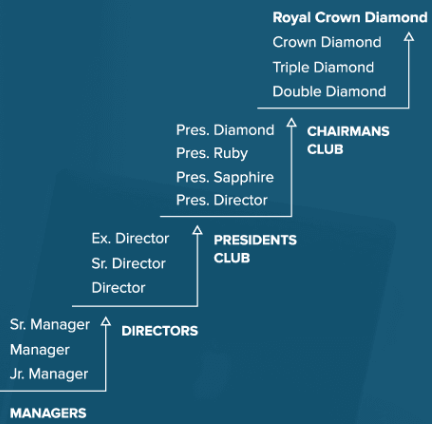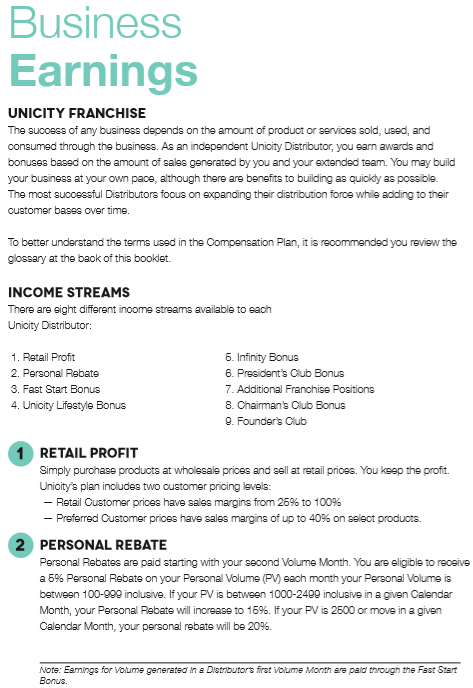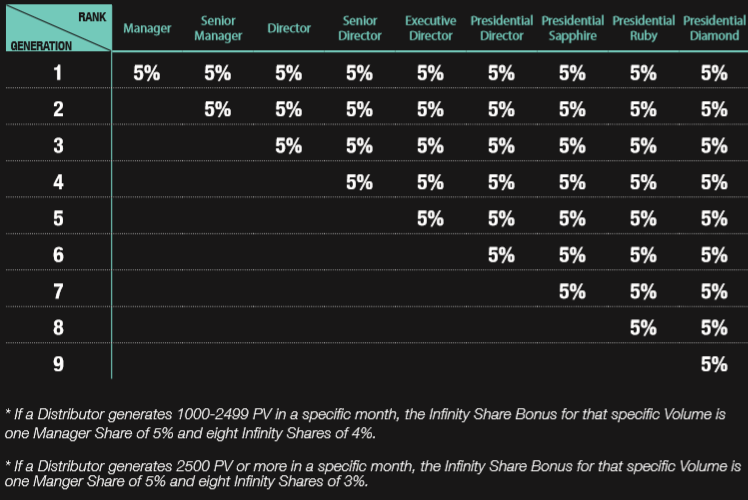Companies selling through true MLM (Multi-Level Marketing) are legal. However some companies that claim to be MLM have questionable practices that may at least border on Pyramid Schemes. Pyramid schemes are illegal.
My hypothetical example below, based on the Unicity MLM structure, shows that over 85% of the retail price of an MLM product may be used to pay for commissions and bonuses etc.
As a result of the profit margins/commissions/bonuses/rebates paid out, customers may pay several times the actual true price of a product (price including reasonable profit margin if it was not MLM) when buying an MLM product. MLM products are definitely not cheap and do not represent value for money.
MLM products are very expensive. How much do you think has to be added to the actual cost of the product (including reasonable profit margin if it was not MLM) to pay for the ‘income streams’ in the example below? What percentage of the retail price (price you would pay as a customer) do you think would be the reasonable price of the product (including a reasonable profit margin) before the MLM costs are factored in?
In addition, the MLM tree structure is very similar to a pyramid structure. Eventually there will not be enough people on Earth for ‘Franchisees’ (or whatever other name is used) at the lower levels to recoup (get back) their ‘investment’. In fact many people do not earn much who entered MLM some time ago.
If someone is selling a product, ask if it is MLM.
Many sales people may avoid answering the question. If they avoid answering by saying it is Direct Selling or Direct Sales, ask again ‘Is it MLM, yes or no?’.
As mentioned, profit margins/commissions/bonuses/levels make an MLM product very expensive. The commissions and bonuses etc have to be factored into the retail price.
I will use Unicity as an example.
Unicity may be no better or worse than other MLM schemes. See:
http://nl.unicitylibrary.com/viewpdf/?pid=138
My analysis below excludes commission payable for commission on commission.
There appear to be up to 14 levels:

In 2015 about 97% of distributors appear to have earned no profit or had a loss:

Source: https://www.finance-guy.net/streetonomic/unicity-review
Below are listed 9(?) income streams (although it says 8).
I wonder what the Founders Club (#9) is and what is their slice of the cake?

Here is the Infinity Bonus (#5, paid up to 9 levels deep):

I have produced a spreadsheet calculating possible effects of the above:
UnicityMLM (hypothetical model- view the pdf)
Even although the above spreadsheet calculations may not be accurate (too many assumptions), the spreadsheet/ pdf demonstrates the effects MLM can have on price of a product.
Note: The extra 5 levels (total 14 levels) in the Infinity bonus table @5% would change the factor to 5 just for the infinity bonus and sales margin.
.
Just this calculation would result in a retail price of $13.75 (without the other income streams).
i.e. Even this price is five times the company cost price!
The other income streams are likely to increase the $13.75 price by maybe at least 50%, resulting in a figure ($20.63) marginally above the $20.45 figure in my initial calculations.
The calculations indicate that a retail price seven times the company cost price may be needed to factor in most of the various commissions and bonuses etc.
So, if we adopt seven as the factor, the retail price would be 7 x $2.75 = $19.25.
The commissions would take up 6/7 (over 85%) of this price ($16.50), with the company cost price 1/7 ($2.75).
The actual manufacturing cost ($1) in this hypothetical example being just over 1/20 of the retail price.
Does this seem fair to you (for the customer)?
Note: If we increase the company price by 10 cents to $2.85 (by increasing components of the price by a total of 10 cents), the retail price would become $19.95 (using the same fractions). This retail price is only 50 cents less than the price calculated on the spreadsheet. Commissions etc would total $17.10.
Regardless, the commission amount/percentage shows how unfair/expensive this type of MLM is for the customer.
What do you think?
The model is hypothetical.
Only Unicity knows the true percentages.
Suppose we consider the $13.75 price mentioned in the note above. This is very unlikely to cover the cost of the commissions/bonuses etc.
In this case the commissions make up 4/5 ($11) of the price and the company cost price 1/5 ($2.75).
In this case let us increase the $2.75 company price to $2.99 by adding a total of 24 cents to the company costs.
The new company cost of $2.99 produces a retail cost of 5 x $2.99 = $14.95.
Now the commissions make up 4/5 ($11.96) of the price and the company cost price 1/5 ($2.99).
We now have a range of values to consider: a manufacturing cost of $1; a company cost of $2.85 – $2.99 and a retail price of $14.95 – $19.95.
Remember $14.95 is unlikely to cover the cost of the commissions/bonuses etc. [Perhaps we should consider a retail price of 6 x 2.99 = $17.94 (say $17.95) to maybe cover most of the commissions?]. An extra $2 is unlikely to cover remaining commissions/bonuses etc.
The product with a small manufacturing cost of $1 is the only thing preventing this from being a pyramid scheme.
We have percentage cost/price ranges (including a profit margin): a manufacturing cost about 5-7% of the retail price and a company costs about 14-20% of the retail price (1 d.p.).
Do you think this is fair on the consumer?
Only Unicity knows the true percentages.
Is this the type of company you would want be in business with?
In the MonaVie example below “fewer than 1% qualified for commissions and of those only 10% made more than $100 per week.”
See:
https://en.wikipedia.org/wiki/MonaVie:
Distributor earnings
Around 14% of distributors made a profit, according to MonaVie Executive VP Henry Marsh quoted from a 2009 Deseret News article.[30] A Newsweek article, reporting on MonaVie’s 2007 Income disclosure statement, stated “fewer than 1% qualified for commissions and of those, only 10% made more than $100 a week.” More than 90% were counted as wholesale customers, whose earnings were mostly discounts on sales to themselves. According to a top recruiter, the dropout rate in 2008 was around 70%.[12] An article published in the Hartford Courant reported that about 45% of the company’s distributors earned an annualized average check of less than $1,600, and 37% took home about $2,000; roughly 2% earned an annualized average check of more than $29,000, and just 7 out of 80,000 distributors (<0.01%) took home more than $3 million, according to MonaVie’s 2008 Income Disclosure statement[31][32] According to a 2011 article in The Salt Lake Tribune, 85% of MonaVie’s distributors earned commission checks in 2009 averaging $35 a week or less, while the company’s top seven distributors earned an average of $3.4 million a year.[33]
Also see:
https://infinitemlmsoftware.com/blog/top-100-mlm-companies-2019
Gifting Circles are definitely a pyramid scheme. See:
https://aaamazingphoenix.wordpress.com/2017/07/17/gifting-circles-stay-away-from-these/
Also see:
https://www.cheatsheet.com/money-career/huge-companies-accused-of-being-pyramid-schemes.html/
Reblogged this on The Bees Knees: Business Knowledge Network (free until 1 July 2019).
Pingback: Instructions & Subscription (maybe free?) – The Bees Knees Business Knowledge Network (free until July 2019)
Pingback: The Bees Knees Business Knowledge Network aka Cloud Tradeshow Support Group aka BizAds123.wordpress.com – The Bees Knees Business Knowledge Network (free until July 2019)
Thanks for this Alan. I have joined a couple of companies as a distributor so I can buy their product cheaper, but it is still expensive and if they insist on autoship for things you may not want to keep buying every month is making money for everyone else but you.
Just for the Infinity bonus (#5), the base price must increase 81.82% (Each $1 becomes $1.82).
i.e. for 5% bonus for each of the 9 levels above (45% total bonus).
For a minimum retail sales margin of 25% the price must increase 33.33% (142.4% increase including Infinity bonus).
i.e. Each $1 becomes $1.33 ($2.42 including Infinity bonus).
I have now calculated the possible results of MLM. See spreadsheet (pdf) below (black) Infinity bonus table.